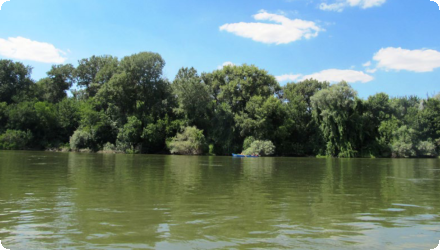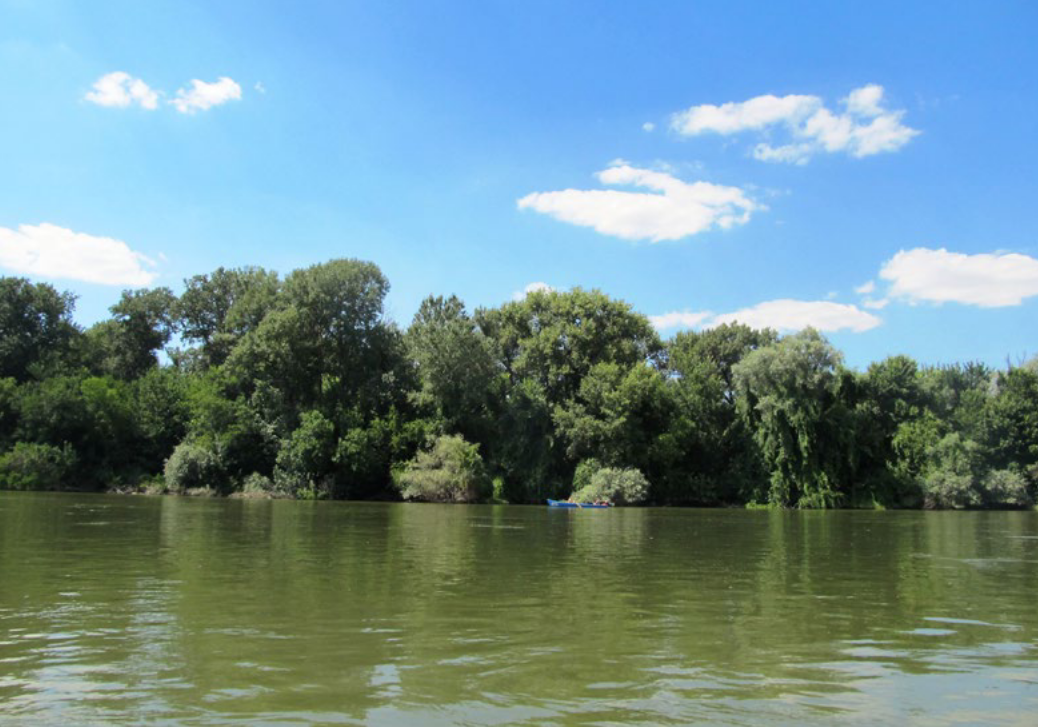Last update
2025
Summary
Executive Forest Agency (EFA) is the coordinating beneficiary and, with WWF, implements a project to protect and restore 11 riparian and wetland habitat types across ~21,000 ha in ten Bulgarian nature parks (Bulgarka, Vitosha, Vratsa Balkan, Golden Sands, Rila Monastery, Ruse Lom, Blue Rocks, Strandja, Shumen Plateau). Building on this, LIFE13 NAT/BG/000801 (Sept 2014–Feb 2019) targeted habitat 91E0* in two Natura 2000 sites—Maritza River (BG0000578) and Marten-Ryahovo (BG0000529)-with actions at Merich Orman and Gushterova Odaya (Maritsa) and on Aleko Island (Danube). In total, 48.1 ha of riparian forests were restored: 24.0 ha through afforestation with native species (e.g., Quercus robur, Ulmus spp., Fraxinus angustifolia, Alnus glutinosa, Populus nigra, Salix alba) and 24.1 ha enhanced using an adapted “Saarland method” to remove invasives and improve stand structure. Monitoring showed variable survival (c. 80% at Marten-Ryahovo; lower on Maritsa after the 2016 drought and riverbed lowering from aggregate extraction), prompting a shift to autumn replanting and adjusted species mixes. Long-term management is secured via 30-year agreements with site managers; national technical guidelines on riparian forest restoration were published in 2018, and follow-up maintenance continues with EFA and the Regional Forest Directorates.
Position
Latitude
43.99
Longitude
26.25
Project
NWRM
National Id
Bulgaria_10
Installation date
2014
Implementation Status
Contact
REC
Transboundary
0
Photo gallery
Location of the project
Various : 10 Bulgarian nature parks - Bulgarka , Vitosha, Vratsa Balkan, Golden Sands Park, Rila Monastery, Ruse Lom, Blue Rocks, Strandja, Shumen Plateau.
Project's objectives
Enhance the conservation status of habitat 91E0* in two Habitats Directive sites by applying a range of restoration techniques and testing alternative silvicultural methods.
Direct restoration through afforestation on 14.2 ha in SCI Maritza River (12.8 ha Merich Orman; 1.4 ha Gushterova odaya).
Direct restoration on 9.8 ha in SCI Marten–Ryahovo (incl. Aleko Island).
Apply an adapted Saarland method (invasive control/structural improvement) on 24.1 ha (22.3 ha Aleko Island; 1.8 ha near Parvomay).
Compile national Guidelines for restoration and management of riparian forest habitats to consolidate baseline information and practice.
Capacity building for EFA, Regional Forest Directorates (Plovdiv, Ruse) and partners; public awareness & stakeholder liaison in target areas.
Connectivity analysis among nearby Natura 2000 sites; submit results to 11 municipalities and propose inclusion in the regional Flood Risk Management Plan.
Direct restoration through afforestation on 14.2 ha in SCI Maritza River (12.8 ha Merich Orman; 1.4 ha Gushterova odaya).
Direct restoration on 9.8 ha in SCI Marten–Ryahovo (incl. Aleko Island).
Apply an adapted Saarland method (invasive control/structural improvement) on 24.1 ha (22.3 ha Aleko Island; 1.8 ha near Parvomay).
Compile national Guidelines for restoration and management of riparian forest habitats to consolidate baseline information and practice.
Capacity building for EFA, Regional Forest Directorates (Plovdiv, Ruse) and partners; public awareness & stakeholder liaison in target areas.
Connectivity analysis among nearby Natura 2000 sites; submit results to 11 municipalities and propose inclusion in the regional Flood Risk Management Plan.
Involved Partners
| Authority type | Authority name | Role | Comments |
|---|---|---|---|
Climate zone
warm temperate moist
Temperature
11.9°C
Precipitation
624
Annual rainfall range
600 - 900 mm
Elevation range
21
Groundwater level
Riparian forests in Bulgaria develop under “high groundwater”
Vegetation class
Riparian forests specifically habitat 91E0 (Alluvial forests with Alnus glutinosa, Fraxinus spp.), with riparian mixed forests also present.
Water bodies: Ecological Status
Moderate
Water bodies: Chemical Status
Failing to achieve good
Water quality status
Household and industrial/untreated discharges near the Maritsa site, hydromorphological modification,and invasive/non-native species as key pressures affecting riparian habitats and water quality.
Project scale
Large
Project scale specification
The wider WWF/EFA programme spans ~21,000 ha across 10 parks.
Project area
21000 ha
Area subject to Land use change or Management/Practice change (ha)
0,800000011920929
Total cost
1236834
Financing authorities
Type of funding
EU-funds: LIFE+
Comments
€615,199
Compensations
0
Policy context
Riparian forests in Bulgaria were in unsatisfactory condition due to drainage of wetlands, diversion and diking of rivers, aggregate extraction (riverbed lowering), use of non-native species, invasive spread, and climate aridization reducing river flow and groundwater. The two target sites (Maritsa River BG0000578; Marten–Ryahovo BG0000529) are Natura 2000 SCIs under the Habitats Directive (92/43/EEC), so the project aimed to restore/maintain favourable status of Annex I habitat 91E0*. The work also fed a new measure into the 2016–2021 Flood Risk Management Plan (East Aegean Region). Nationally, it aligns with the Biological Diversity Act and Water Act framework for riparian areas.
Land ownership
State forest land and municipal forest land
Community involvment
No
Design consultation activity
| Activity stage | Name | Key issues | Comments |
|---|
Policy target
| Target purpose |
|---|
Policy pressure
| Pressure directive | Relevant pressure |
|---|
Policy impact
| Impact directive | Relevant impact |
|---|
Requirement directive
| Requirement directive | Specification |
|---|
Contractual arrangements
0
| Arrangement type | Responsibility | Role | Name | Comments |
|---|
Part of wider plan
0
Wider plan type
| Wider plan type | Wider plan focus | Name | Comments |
|---|
Stands and Saarland-treated plots are checked at least once per year with a formal inventory, by local SFEs/SHE under RFDs, within EFA’s legal monitoring mandate.
The program tracks survival (“striking roots”) and replenishment needs of planted trees; species composition and stand structure (especially where the Saarland method aims to reduce non-native/invasive species and improve structure); and site pressures such as illegal dumping, industrial discharges, grazing and fire risk near access roads. The annual inventories record stand condition, while the guidelines call for phytocoenotic and continuous habitat monitoring to trigger corrective actions if needed.
Maintenance
Routine aftercare (weeding, soil work, watering, gap-filling) plus invasive-control and annual Saarland method touch-ups are carried out by SFEs/SHE with RFD oversight.
Awareness raised (≈5,000 exhibition viewers), strong volunteer participation (≈90 volunteers; 80 children), new outdoor green classroom, municipal and FRMP planning uptake.
In the broader Lower Danube restoration portfolio that includes this work, economic studies found benefits (ecosystem services, disaster mitigation) outweigh costs, reported at landscape scale.
In the broader Lower Danube restoration portfolio that includes this work, economic studies found benefits (ecosystem services, disaster mitigation) outweigh costs, reported at landscape scale.
Information on retained water
Riparian buffers regulate evaporation, keep groundwater near the surface, improve water quality and help flood control.
1
Change in habitat extent: in Marten–Ryahovo, the 9.8 ha add >1% to the site’s mapped 91E0* habitat (229.36 ha total).
Conversion of hybrid poplar plantation to native willow–poplar on Aleko; Saarland works aimed to reduce invasives and improve stand structure (effects acknowledged as too early to conclude; repeated treatment foreseen for ~5 years).
High mortality at Gushterova odaya under drought and lowered groundwater; species-specific survival (e.g., black poplar, ash, oak fared better than alder, willow). Response: switch to autumn planting and adjust mixes; intensify aftercare.
Conversion of hybrid poplar plantation to native willow–poplar on Aleko; Saarland works aimed to reduce invasives and improve stand structure (effects acknowledged as too early to conclude; repeated treatment foreseen for ~5 years).
High mortality at Gushterova odaya under drought and lowered groundwater; species-specific survival (e.g., black poplar, ash, oak fared better than alder, willow). Response: switch to autumn planting and adjust mixes; intensify aftercare.
Key lessons
Selecting locally sourced reproductive material and giving seedlings the right preparatory care is critical. The national guidelines require the origin of forest reproductive material to match the region of planting, and field results showed species-specific survival differences that led the team to adjust mixes and switch final replenishment to autumn. This directly echoes the NWRM lesson on seedling origin and care.
Long-term success depends on integration into planning and governance. The project prepared technological plans approved by EFA and the regional environmental inspectorates, delivered a connectivity analysis to 11 municipalities, and proposed a measure for the 2016–2021 Flood Risk Management Plan, all to lock in management after project end. Thirty-year agreements with site managers further secure continuity.
Follow-up care and invasive-species removal are necessary. Sites required repeated weeding, soil loosening, watering and replanting, plus application (and re-application) of the adapted Saarland method to suppress rivals and improve stand structure - exactly matching the NWRM lesson on aftercare and invasive control.
Hydrology sets the limits. A 2016 drought and riverbed lowering from aggregate extraction depressed survival at Gushterova odaya, underlining that restoration must account for external pressures and that sometimes the first step is to curb the degradation driver. Broader Lower Danube experience reinforces the need to juggle multiple parameters and to test approaches before scaling.
Long-term success depends on integration into planning and governance. The project prepared technological plans approved by EFA and the regional environmental inspectorates, delivered a connectivity analysis to 11 municipalities, and proposed a measure for the 2016–2021 Flood Risk Management Plan, all to lock in management after project end. Thirty-year agreements with site managers further secure continuity.
Follow-up care and invasive-species removal are necessary. Sites required repeated weeding, soil loosening, watering and replanting, plus application (and re-application) of the adapted Saarland method to suppress rivals and improve stand structure - exactly matching the NWRM lesson on aftercare and invasive control.
Hydrology sets the limits. A 2016 drought and riverbed lowering from aggregate extraction depressed survival at Gushterova odaya, underlining that restoration must account for external pressures and that sometimes the first step is to curb the degradation driver. Broader Lower Danube experience reinforces the need to juggle multiple parameters and to test approaches before scaling.
Success factor(s)
| Success factor type | Success factor role | Comments | Order |
|---|---|---|---|
|
Successful coordination between authorities
|
main factor
|
Strong public–NGO partnership and local implementers: EFA, RFDs and WWF, with direct involvement of SFE Asenovgrad/Parvomay and SHE “Danube”, plus EFA’s legal monitoring mandate. |
|
|
Other
|
main factor
|
Use of native, locally sourced stock & adaptive practice: origin-matched material; shift to autumn planting and better-performing species after early mortality. |
|
|
Communication activities
|
secondary factor
|
Awareness & volunteers supporting aftercare (events, exhibition, green classroom, on-site help). |
Driver
| Driver type | Driver role | Comments | Order |
|---|
Transferability
Highly transferable to similar European riparian corridors, provided you use locally sourced stock and embed actions in forest planning, ensure intensive aftercare plus repeated invasive control, and assess hydrological constraints (e.g., drought, riverbed lowering) and tenure early; sustained monitoring is essential.
English

